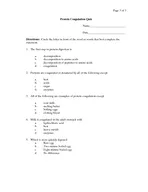/


A chemical change has taken place because a new substance is produced Blood coagulates clots to stop further bleeding The first step in protein digestion is coagulation In this experiment you will learn several ways in which proteins are coagulated ID: 42199
Download Pdf The PPT/PDF document "Page of PROTEIN COAGULATION OR DENATUR..." is the property of its rightful owner. Permission is granted to download and print the materials on this web site for personal, non-commercial use only, and to display it on your personal computer provided you do not modify the materials and that you retain all copyright notices contained in the materials. By downloading content from our website, you accept the terms of this agreement.
Page 1 of 3 PROTEIN COAGULATION OR DENATURATION Submitted by Rita Snyder Problem: How are proteins coagulated or denatured? When proteins are coagulated they clump into a semi-soft, solid-like substance. A chemical change has taken place because a new substance is produced. Blood coagulates (clots) to stop further bleeding. The first step in protein digestion is coagulation. In this experiment you will learn several ways in which proteins are coagulated. Materials: raw eggs flour 250-ml beaker evaporating dish tripod watch glass wire gauze forceps Bunsen Burner test tube milk medicine dropper dilute hydrochloric acid Procedures: Coagulation of Egg White 1. Half fill a 250-mL beaker with water. Place it on a tripod and boil the water gently. 2. Turn off the Bunsen burner. Drop some egg white into the hot water. Wait two or three minutes and record your observations. 3. Remove about half of the coagulated egg white with forceps, and place it on your watch glass. Resume boiling the remaining egg white for five more minutes. Compare the raw egg white, the two-to-three-minute egg white, and the eight-minute egg white. Record your observations. The Coagulation of Milk Protein 4. Add one inch of milk to a test tube. Add hydrochloric acid to the milk, with a medicine dropper, until a change is seen. Record your observations. 5. Allow the test tube to stand undisturbed for five minutes. Decant the liquid. Describe the residue in the test tube; which food does it resemble? 1. Which is easier to digest, a hard-boiled egg or a raw egg; sour milk or sweet milk? Explain. 2. How is milk coagulated in the stomach? Page 2 of 3 3. Why does boiled milk develop a skin? 4. List two ways in which proteins are coagulated? 5. Why is baked bread easier to digest than unbaked dough? Page 3 of 3 Protein Coagulation Quiz Name_________________________ Date__________________________ Directions: Circle the letter in front of the word or words that best complete the statement. 1. The first step in protein digestion is a. decomposition b. decomposition to amino acids c. decomposition of peptones to amino acids d. coagulation 2. Proteins are coagulated or denatured by all of the following except a. heat c. sugar d. enzymes 3. All of the following are examples of protein coagulation except a. sour milk b. melting butter c. boiling eggs d. clotting blood 4. Milk is coagulated in the adult stomach with a. hydrochloric acid c. heavy metals d. enzymes 5. Which is more quickly digested a. Raw egg b. Two-minute boiled egg c. Eight-minute boiled egg d. No difference